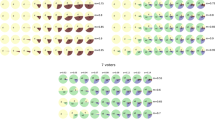Abstract
The Condorcet Jury Theorem implies that the collective performance of a group, in arriving at a “correct” judgment on the basis of majority or plurality rule, will be superior to the average performance of individual members of the group, if certain apparently plausible conditions hold. Variants of the Jury Theorem are reviewed, particularly including the politically relevant variant that allows for conflicting interests within the group. We then examine two kinds of empirical data. First, we compare individual and collective performance in a large number of multiple-choice tests, and we find that collective performance invariably and substantially exceeds average individual performance. Second, we analyze American National Election Study data to create dichotomous-choice tests concerning positions of candidates on a variety of political issues; Condorcet-like effects are again evident. Finally, continuing to use NES data, we construct, on each political issue, a simulated referendum (direct voting on the issue) and election (indirect voting on the issue by voting for candidates on the basis of their perceived positions on the issue), and we compare the two results. Despite high rates of individual error, electoral error is quite small, and collective performance is fairly high, providing evidence of Condorcet-like effects in situations of conflicting preferences.
Similar content being viewed by others
References
Allen, Kenneth W. (1974). “Individual Errors and Aggregate Effects in Voting.” Unpublished paper, University of Maryland Baltimore County.
BerelsonBernard, PaulLazarsfeld, and WilliamMcPhee. (1954).Voting. Chicago: University of Chicago Press.
BergSven. (1993). “Condorcet's Jury Theorem, Dependency Among Jurors,”Social Choice and Welfare 10, 87–95.
Berg, Sven. (1994). “Majority Functions Based on Extensions of the Binomial Distribution.” Paper presented at the Second International Conference of the Society for Social Choice and Welfare, Rochester, New York, July 8–11.
BlackDuncan. (1958).The Theory of Committees and Elections. Cambridge: Cambridge University Press.
DownsAnthony. (1957).An Economic Theory of Democracy. New York: Harper & Row.
GrofmanBernard. (1975). “A Comment on ‘Democratic Organization: A Preliminary Mathematical Model,’”Public Choice 21, 99–103.
GrofmanBernard. (1978). “Judgmental Competence of Individuals and Groups in a Dichotomous Choice Situation: Is a Majority of Heads Better Than One?”Journal of Mathematical Sociology, 6, 497–560.
GrofmanBernard, GuillermoOwen, and ScottFeld. (1983). “Thirteen Theorems in Search of the Truth,”Theory and Decision 15, 261–278.
GrofmanBernard, and ScottFeld. (1988). “Rousseau's General Will: A Condorcetian Perspective,”American Political Science Review 82, 567–576.
KeyV.O.Jr. (1966).The Responsible Electorate. Cambridge, MA: Harvard University Press.
LadhaKrishna K. (1992). “The Condorcet Jury Theorem, Free Speech and Correlated Voters,”American Journal of Political Science 36, 617–634.
LadhaKrishna K. (1993). “Condorcet's Jury Theorem in Light of De Finetti's Theorem,”Social Choice and Welfare 10, 69–85.
McKelveyRichard D., and Peter C.Ordeshook. (1985). “Elections with Limited Information: A Fulfilled Expectations Model Using Contemporaneous Poll and Endorsement Data as Information Sources,”Journal of Economic Theory 36, 55–85.
McKelveyRichard D., and Peter C.Ordeshook. (1986). “Information, Electoral Equilibrium, and the Democratic Ideal,”Journal of Politics 48, 909–937.
McKelveyRichard D., and Peter C.Ordeshook. (1990). “Information and Elections: Retrospective Voting and Rational Expectations.” In John A.Ferejohn and James H.Kuklinski (eds.),Information and Democratic Processes. Urbana: University of Illinois Press.
MillerNicholas R. (1986a). “Information, Electorates, and Democracy: Some Extensions and Interpretations of the Condorcet Jury Theorem.” In BernardGrofman and GuillermoOwen (eds.),Information Pooling and Group Decision Making. Greenwich: JAI Press.
MillerNicholas R. (1986b). “Public Choice and the Theory of Voting: A Survey.” In SamuelLong (ed.),Annual Review of Political Science, Vol. 1. Norwood, NJ: Ablex Publishing Corporation.
OwenGuillermo, BernardGrofman, and Scott L.Feld. (1989). “Proving a Distribution-Free Generalization of the Condorcet Jury Theorem.”Mathematical Social Sciences 17, 1–16.
PageBenjamin I., and Robert Y.Shapiro. (1992).The Rational Public. Chicago: University of Chicago Press.
SchumpeterJoseph A. (1942).Capitalism, Socialism, and Democracy. New York: Harper & Row.
ShapleyLloyd, and BernardGrofman. (1984). “Optimizing Group Judgmental Accuracy in the Presence of Interdependencies,”Public Choice 43, 329–343.
Author information
Authors and Affiliations
Rights and permissions
About this article
Cite this article
Miller, N.R. Information, individual errors, and collective performance: Empirical evidence on the Condorcet Jury Theorem. Group Decis Negot 5, 211–228 (1996). https://doi.org/10.1007/BF02400944
Issue Date:
DOI: https://doi.org/10.1007/BF02400944




